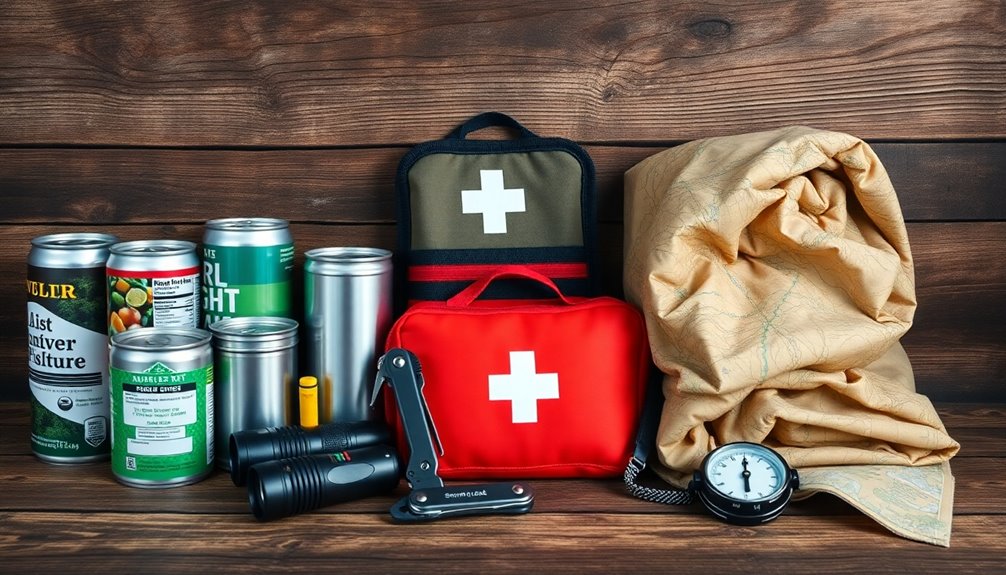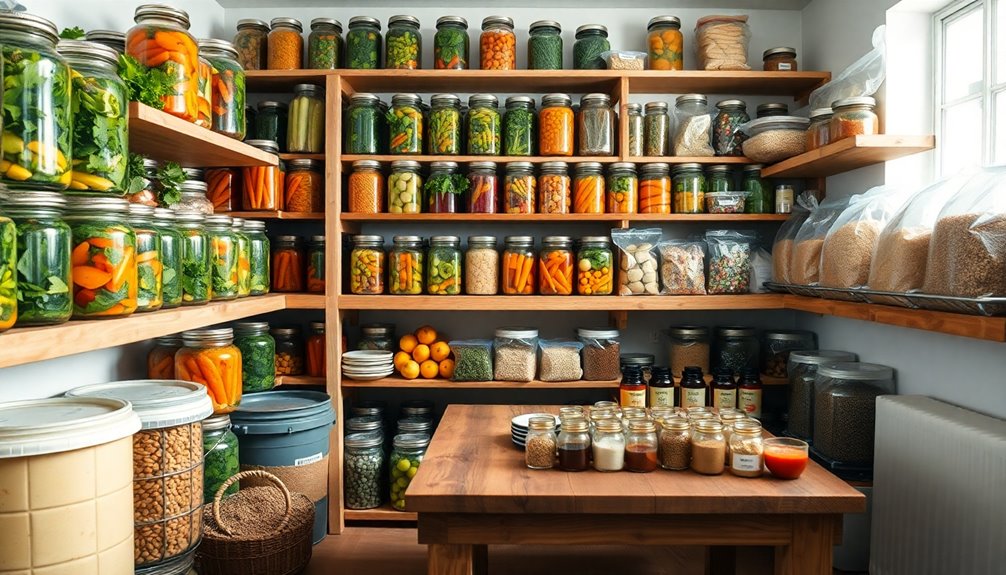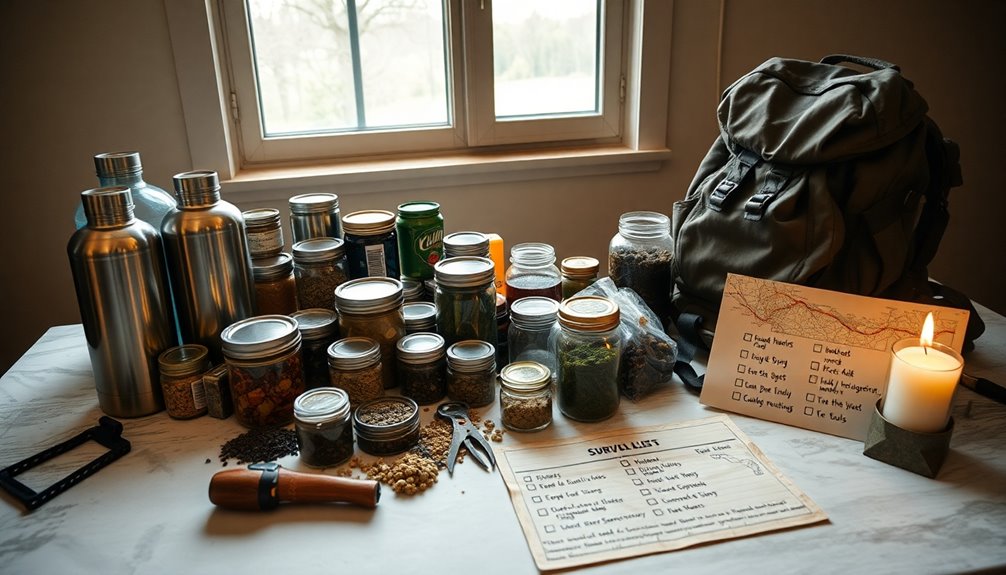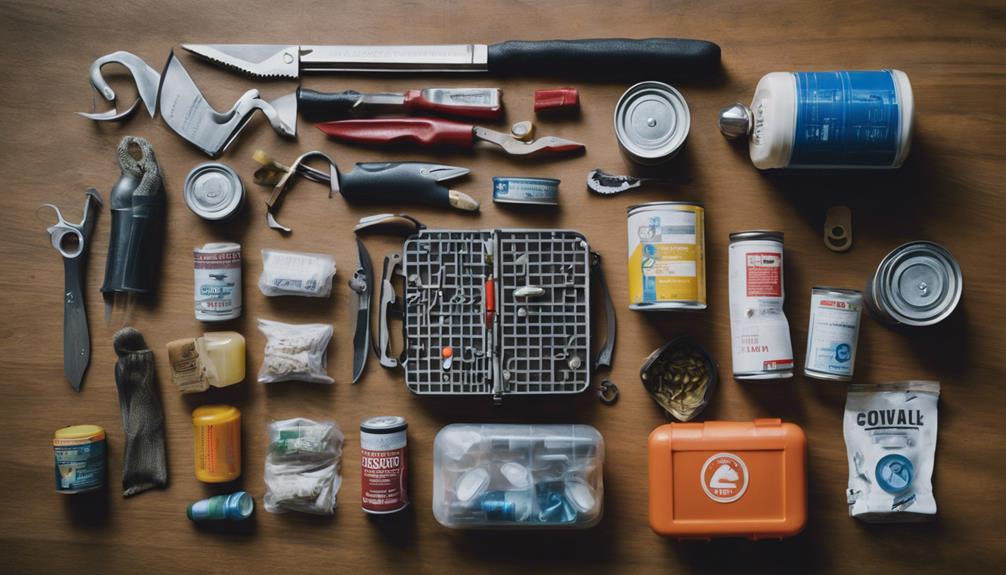To prepare for doomsday, you need a solid plan. Start by stocking essential supplies like non-perishable food and water—aim for one gallon per person daily. Don’t forget a well-equipped first aid kit and hygiene products. Learn effective water management and food storage techniques to prolong shelf life. Secure power sources with a generator or solar charger, and maintain communication tools like a HAM radio. Finally, prioritize your safety with self-defense items. A well-rounded preparation can make all the difference when disaster strikes. Explore further to uncover even more critical strategies and resources for your survival plan. Additionally, consider investing in doomsday survival gear essentials such as durable clothing, sturdy footwear, and multi-tools that can aid in a variety of situations. It’s also wise to create a network with like-minded individuals, as sharing knowledge and resources can enhance your overall preparedness. Regularly review and update your supplies, ensuring that everything remains in good condition and that you are ready for any emergency that may arise.
Key Takeaways
- Stock at least three days' worth of non-perishable food and one gallon of water per person per day for sustenance during disasters.
- Assemble a comprehensive first aid kit with essential items like bandages, antiseptics, and over-the-counter medications for effective injury management.
- Implement a communication plan with family, utilizing tools like HAM radios and solar chargers to maintain contact during emergencies.
- Equip your home with security measures such as door barricades and personal alarms to enhance safety against potential threats.
- Regularly review and update your emergency supplies, medications, and financial plans to ensure preparedness for unexpected situations.
Importance of Preparedness

When it comes to emergencies, being prepared can make all the difference in your survival. Emergency preparedness isn't just a good idea; it's fundamental. You need to have a well-stocked supply of food supplies, water containers, and a first aid kit ready for immediate use. Having these fundamental items on hand guarantees you can effectively respond when disaster strikes, reducing panic and confusion.
Think about the types of emergencies that could affect you and plan accordingly. Stocking up on food with a long shelf life is essential, as it provides sustenance during uncertain times.
Don't forget hygiene items and blankets; they're important for comfort and safety. Regularly reviewing and updating your supplies will keep everything fresh and usable.
Accessing resources like the Red Cross Store can enhance your preparedness efforts, offering various survival kits tailored to different scenarios.
Essential Survival Supplies

Being prepared means having the right supplies on hand for survival situations. Your emergency kit should include a minimum of three days' worth of non-perishable foods, such as canned goods and shelf-stable foods, along with one gallon of water per person per day, as FEMA recommends. This guarantees you have the basics for initial survival during emergencies.
Don't forget essential first aid supplies, which should encompass bandages, antiseptics, pain relievers, and personal hygiene items. These are imperative for managing injuries and maintaining health when access to medical facilities is limited.
Additionally, multi-tools and emergency tools like duct tape, flashlights with extra batteries, and portable chargers can help you tackle various challenges during a disaster.
It's also essential to include water purification methods, such as water purifier tablets and portable filtration systems, to guarantee you have safe drinking water when needed.
Finally, regularly rotating food supplies and maintaining an inventory of your emergency supplies will help keep your provisions fresh and usable. Remember, the selection of essential survival gear is critical to ensure you are adequately equipped for any unexpected situation.
Water Management Strategies

Effective water management strategies are essential for guaranteeing an adequate supply during emergencies. You should aim to store at least one gallon of potable water per person per day, ideally for a minimum of three days.
Using 5-gallon containers for water storage is more efficient than relying on bottled water, as it reduces waste and allows for easier filling and transport.
Consider implementing rainwater collection systems to supplement your emergency supply. By using barrels to collect and store rainwater, you can have an additional source of water when needed.
However, remember that not all water is safe for consumption. Familiarize yourself with various water purification methods, like boiling, chemical treatments, or filtration systems, to confirm the safety of non-potable sources.
Lastly, labeling containers is imperative. Clearly mark which containers hold potable water and which contain non-potable sources to prevent any mix-ups.
This simple practice can save lives in emergencies, making certain everyone in your group has access to safe drinking water.
Food Storage Techniques

When it comes to food storage techniques, you need to focus on long-term preservation and effective inventory management.
Using methods like vacuum sealing and Mylar bags can dramatically extend the shelf life of your supplies.
Plus, implementing a first-in, first-out system guarantees you're using older items before they expire, keeping your stock fresh and safe.
Long-term Food Preservation
Long-term food preservation is essential for anyone looking to prepare for unexpected events or simply reduce food waste.
It's critical to implement effective techniques to guarantee your emergency food supplies last as long as possible. Canning is a popular method, sealing food in jars and heating them, resulting in a shelf life of 1 to 5 years.
Vacuum sealing is another great choice; it removes air from storage bags, considerably extending the shelf life of items like dried fruits and meats by preventing oxidation.
Dehydration removes moisture from foods, allowing you to store fruits, vegetables, and meats for years while retaining most nutrients and flavors when rehydrated.
For even longer storage, consider freeze-dried foods, which can last over 25 years by freezing the food and removing moisture through sublimation.
Proper labeling is crucial. It helps you track what you have and when it was stored.
By following the "first in, first out" method, you can maintain freshness and minimize waste.
Implementing these strategies guarantees your long-term storage is efficient and effective, keeping your food preservation efforts on point.
Rotation and Inventory Management
Maintaining a well-organized food storage system is essential for maximizing the shelf life of your supplies and guaranteeing you can access what you need in an emergency. Start by labeling all food items with purchase and expiration dates. This helps you track freshness and usability effectively.
Implement a "first in, first out" (FIFO) rotation system, using older items before newer ones. This minimizes waste and keeps your emergency food supply ready for use.
Regularly inspect your inventory every three to six months. Remove expired items and replenish your supplies as necessary. Keeping a written inventory list of all stored food items simplifies this process. Note quantities and expiration dates to streamline meal planning during emergencies.
Store non-perishable foods in a cool, dry place, and remember to date opened items. This organization guarantees you maintain safety and quality. Additionally, ensure that your storage area is free from allergens, as this can further enhance the safety of your food supply.
Medical Preparedness Essentials

When preparing for emergencies, a well-stocked first aid kit is essential for addressing injuries and health issues.
Make sure you have the right supplies, including bandages and antiseptics, and keep your prescription medications up to date.
Being ready with both can make a significant difference in a crisis.
First Aid Kit Essentials
A well-stocked first aid kit is indispensable for anyone preparing for emergencies, guaranteeing you can address a variety of injuries effectively. Start by including essential items like bandages, antiseptic wipes, adhesive tape, gauze pads, and scissors. These tools are essential for providing immediate medical care.
Don't forget to stock hygiene products, such as hand sanitizer and disposable gloves. Keeping things clean during an emergency situation can prevent infections and promote better healing.
Over-the-counter medications are also crucial; make sure to include pain relievers like ibuprofen or acetaminophen, antihistamines for allergic reactions, and anti-diarrheal medications for gastrointestinal issues.
While it's important to have prescription medications on hand, remember to regularly check their expiration dates to confirm they're effective when you need them most.
Additionally, consider adding an emergency medical guide or manual. This resource can provide significant information on treating injuries and illnesses when professional help isn't available.
Prescription Medications Availability
Having a reliable supply of prescription medications is vital for your medical preparedness during emergencies. You should make certain you have enough to last at least two weeks, as access to pharmacies may be compromised.
Regularly check the expiration dates on your medications and replace any expired ones to maintain an effective supply during a crisis.
It's important to keep a detailed list of all your prescription medications, including dosages and prescribing doctors. This list will make it easier to communicate with healthcare providers if you need assistance.
Store your medications in a cool, dry place to preserve their efficacy, and consider using waterproof containers to protect them from environmental damage.
Finally, consult with your healthcare provider about obtaining extra refills or emergency prescriptions ahead of potential disasters. Being proactive in your planning will make certain you're prepared when an emergency arises. Understanding financial planning during divorce can also help you allocate resources effectively for emergencies.
Power and Energy Sources

Power and energy sources are vital for effective doomsday preparation. When a power outage strikes, you need reliable backup power to keep your essential devices running. Generators are a great option, but you'll want to verify you have proper fuel storage for operational readiness.
Solar systems also offer renewable energy solutions, allowing you to harness the sun's power for your electricity needs.
Consider these backup power sources:
- Generators: These provide a consistent power supply during outages.
- Solar Chargers: Perfect for maintaining small electronics, keeping communication lines open.
- Vehicle Outlets: Many cars come with 120-volt outlets for on-the-go power access.
Understanding energy consumption plays an important role in your preparations. By knowing how much power you need, you can select the best combination of backup options.
This approach not only enhances your operational readiness but also guarantees that you're equipped to handle unexpected disasters effectively.
Investing in both generators and solar systems can greatly improve your chances of staying powered up when it matters most.
Personal Safety Measures

When facing potential threats during a doomsday scenario, personal safety measures become just as important as securing power sources. To guarantee your well-being, it's vital to develop a robust plan that includes self-defense tactics, situational awareness, and portable security systems.
Here's a quick reference table to help you with your planning:
| Personal Safety Measure | Description |
|---|---|
| Self-Defense Tools | Use pepper spray and personal alarms for immediate protection. |
| Emergency Supplies | Stock up on first aid kits and food storage to stay safe and nourished. |
| Portable Security | Invest in door barricades and window alarms to enhance home safety. |
Training in self-defense techniques empowers you to respond effectively during crises. Understand local laws about self-defense to guarantee your actions remain lawful. Practicing situational awareness helps you spot potential threats early, allowing you to avoid dangerous situations. Additionally, maintaining a strong social support system can enhance your resilience during challenging times. By prioritizing personal safety, you're not just surviving; you're equipping yourself to thrive amidst uncertainty.
Communication Resources

In times of crisis, effective communication can make all the difference in guaranteeing your safety and coordinating with loved ones. To enhance your communication resources, consider the following essentials:
- Keep a written list of emergency contacts: Jot down important phone numbers, including local services, for quick access when networks may go down.
- Invest in a HAM radio or hand-crank radio: These devices can help you connect with others and access emergency broadcasts when traditional communication fails.
- Utilize walkie-talkies: Perfect for short-distance communication, walkie-talkies allow you to coordinate with your group without relying on cellular networks.
Also, don't forget about solar-powered chargers. They're essential for keeping your communication devices charged, especially during prolonged power outages.
Regularly practice your communication plan with family members to guarantee everyone knows what to do when disaster strikes. Being prepared means you can respond effectively and stay connected, even in the most challenging situations.
Frequently Asked Questions
What Are the 10 Essential Survival Kit Items?
When you're packing a survival kit, focus on essentials that'll sustain you in emergencies.
Start with non-perishable food and at least nine gallons of clean drinking water.
Don't forget an extensive first aid kit to handle injuries.
Include a reliable multi-tool for various tasks, and have flashlights or solar-powered lanterns for lighting.
Finally, add a whistle for signaling help and a fire starter to cook food or keep warm.
What Should I Stockpile for Doomsday?
Imagine a modern-day knight preparing for battle; you need to stockpile essentials for any disaster.
Start with two weeks of non-perishable food and at least a gallon of water per person daily.
Don't forget a well-equipped first aid kit and versatile cooking gear like a portable camp stove.
Regularly rotate your supplies to keep them fresh, and maintain an inventory to track what you've got.
Being prepared now means you'll face challenges with confidence later.
What Should Be in a 72 Hour Emergency Kit?
In a 72-hour emergency kit, you need to pack essentials for survival.
Start with at least three gallons of water for drinking and sanitation. Include non-perishable food like canned goods or energy bars.
Don't forget a first aid kit with bandages and any prescription medications. A reliable flashlight with extra batteries and matches for fire are vital.
Finally, store important documents in a waterproof container for easy access during emergencies.
What to Pack in a Go Bag for When Disaster Strikes?
Did you know that nearly 60% of Americans aren't prepared for a disaster?
When packing your Go Bag, start with essentials like non-perishable food, water, and a first aid kit.
Don't forget a multi-tool, flashlight, and portable phone charger.
Pack weather-appropriate clothing, sturdy shoes, and thermal blankets for comfort.
Include hygiene items and a written emergency plan, along with important documents and contacts, to guarantee you're ready when disaster strikes.
Conclusion
In the face of uncertainty, being prepared is your lifeline, a sturdy raft in a stormy sea. By gathering essential supplies and honing your survival skills, you're not just waiting for disaster; you're taking charge of your fate. Remember, it's not just about surviving but thriving through adversity. So, gear up, stay informed, and build your own fortress of resilience. When the winds of chaos blow, you'll stand tall, ready to face whatever comes your way!










